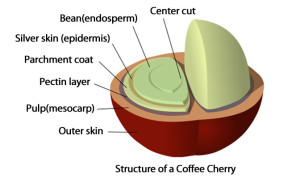Processing and Handling and Coffee Taste
Processing and Handling as Inputs to Cup Flavor
The final piece to the flavor puzzle is the role of handling the ripe coffee fruit and how it’s prepared by the coffee processors. Farmers around the world generally sell their ripe fruit with the coffee “bean” inside it to a processing mill where the outer fruit is removed and the remaining seed is dried and made ready for roasting into the coffee we recognize. As you might imagine, a lot can happen in the handling. Far too many lots of coffees that could qualify as specialty grade coffee are ruined by poor handling between the farm and the consumer. 
Choices in traditional processing methods used in the various regions have generally developed over time to adapt to local conditions and what the market wants. Processing method is usually chosen to turn the coffee cherry and seed into an unroasted bean with efficiency and speed, e.g., to get paid fastest and most. Producers use the method that suits the available resources (such as availability of water) and results in a saleable product. In Yemen, for example, there is little water for processing, so farmers allow the fruit to dry on the tree or on tarps on a roof, and the fruit pulp is removed after the coffee is dried. In Kenya, there is abundant water, so processors ferment the fruit overnight before removing the pulp and washing the seeds before drying.
Processing method also impacts flavor profiles and mouth feel of even the same varietal, so that a Bourbon grown at high altitude in Rwanda and prepared using traditional “washed” methods tastes very different from a Bourbon grown at a lower altitude in Zambia and dry processed. Much of the appeal of Sumatra coffees comes from the complexity that comes from the semi-washed (wet hulled) Gilleng Basah processing method commonly used. In that method, the partially-hulled coffee is dried in the open, sometimes on patios or tarps on the ground in very high humidity, allowing for all manner of interesting flavors to attach to the beans and making for a rustic, more complex cup. By contrast, the washed coffees of Kenya and East Africa, where great effort is spent in protecting the drying beans from tainting, have pristine clean, sparkling profiles with extremely well-defined flavors. Brazil natural processed coffees are allowed to dry with the pulp on the bean before being milled because the goal is to create a coffee with big body and the well-known “Brazilian” profile. It’s important to note that there are some very interesting coffees being produced by farmers experimenting with non-traditional processing methods of traditional varietals. Who knows where it will all end?
Common processing methods of NanoRoast coffees:
Washed process – Cherry is washed and sometimes fermented overnight, pulp is removed and the seed is dried in the sun on a raised bed
Pulp Natural process – Outer layer of the cherry is mostly removed from seed, seed is dried on a patio, then cherry pulp is removed by a mechanical pulper
Dry (Natural) process – Coffee seed is dried in the whole cherry, then pulp is removed mechanically
Semi-washed/wet-hulled (Gilleng basah) – the traditional method used in Indonesia in which the cherry is washed and roughly pulped as in Natural process, then dried on a tarp on the ground in very open, humid conditions
Miel/Honey Process – Coffee begins the drying process in the cherry as in dry/natural process, but after a fairly short period, it’s pulped, washed and finished like a washed process coffee. It saves a lot of water, so expect to see more of these in the future. Depending on how long the cherry is left on the seed, the result can add fruity notes to the resultant coffee.
A Note from NanoRoast: Our importer partners cup each lot at the processor or farm and insist on proper handling techniques along all the chain to their stateside docks. They then cup the coffee again once it arrives to ensure that the quality is maintained. We then re-test each batch before it goes to you. When it’s in your hands, extra attention to good brewing technique can make sure that all the inputs to your very special coffee pay off where it counts–in the cup. Read up on brewing tips here.
Browse for interesting coffees here.

